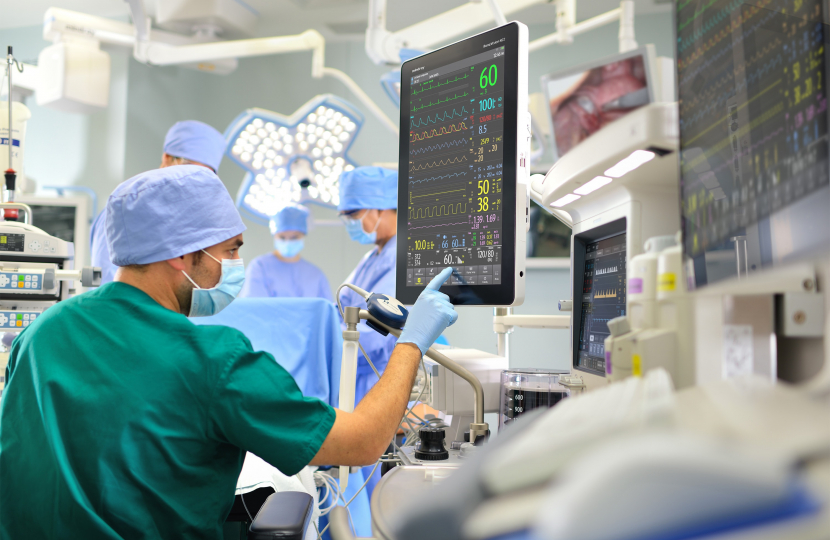
Funding aims to relieve pressures on hospitals and help cut waiting lists, one of the government’s top five priorities
- £250 million of government funding has been allocated to NHS hospitals to increase capacity as part of the Urgent and Emergency Care Recovery Plan
- Funding will create 900 beds in hospitals to treat patients more quickly, and cut waiting lists
- Part of plans to increase capacity and improve performance ahead of winter and deliver an additional 5,000 permanent beds
Nine hundred new hospital beds will be delivered across the NHS as part of £250 million government funding to help treat patients more quickly this winter.
The funding has been awarded to NHS trusts to relieve pressures and help cut waiting lists, one of the government’s top five priorities.
Thirty NHS organisations across England will benefit from the investment in urgent and emergency care services. This includes developing or expanding urgent treatment centres and same day emergency care services which will help patients to be seen more quickly, without being admitted to hospital. NHS England expects that the majority of schemes will be completed by January to help deal with winter pressures.
This investment is part of the NHS Urgent and Emergency Care Recovery Plan, published in January, which set out plans to provide over 5,000 additional permanent, fully staffed hospital beds in total, with the NHS on track to deliver this by winter. These new 900 beds are part of this commitment.
Prime Minister, Rishi Sunak, said: "Cutting waiting lists is one of my top five priorities, so this year the government has started planning for winter earlier than ever before and the public can be reassured we are backing the NHS with the resources it needs.These 900 new beds will mean more people can be treated quickly, speeding up flow through hospitals and reducing frustratingly long waits for treatment."
In total, the schemes will create 900 beds which includes over 60 intermediate care beds and improving assessment spaces and cubicles in A&E.
Examples of schemes include University Hospitals Sussex NHS FTl, where £4,496 000 is being invested.
Several trusts will develop or expand urgent treatment centres to treat patients more quickly, helping to reduce waiting times, including Hull Royal Infirmary, James Cook University Hospital, Airedale General Hospital and Worthing Hospital.
Some trusts will also use the funding to develop or expand same day emergency care services, including in Whipps Cross Hospital, Royal Surrey County Hospital, Croydon University hospital and Worthing Hospital. Same day emergency care services help to assess, diagnose and treat patients more quickly, without needing to be admitted to a hospital ward.
These measures will support the NHS’ recovery from the pandemic, and ensure that patients receive the care they need, when they need it. Alongside this, the NHS Long-Term Workforce Plan will put the NHS on a sustainable footing by delivering the biggest training expansion in NHS history and recruiting and retaining hundreds of thousands more staff over the next 15 years.
Patients are already seeing improvements as a result of the Urgent and Emergency Care Recovery Plan, backed by record funding – with average category 2 ambulance response times down by 27 minutes on July last year, and down by 60 minutes on the peak of winter pressures seen in December 2022.
The plan also includes a commitment for 800 new ambulances, including specialist mental health ambulances to improve response times this winter.
The schemes will also operate alongside the NHS’ new ‘care traffic control’ centres which will identify and co-ordinate the best and quickest options for patients to be safely discharged from hospital when they’re ready – either at home or into social or community care.
The centres will bring together teams from across the NHS, social care, housing, and voluntary services in one place to help make live decisions and offer patients everything they need in one place.
Earlier this month, the NHS announced its world-leading virtual ward programme would be expanding to children, with overall virtual ward bed numbers expected to hit 10,000 by the autumn.
This capital funding is on top of the existing investment as part of the Urgent and Emergency Care Recovery Plan, with £1 billion of dedicated funding to support capacity in urgent and emergency services, building on the £500 million used last winter. The government has also invested £200 million into ambulance services to increase the number of ambulance hours on the road, as well as a further £1.6 billion of funding for social care to reduce the numbers of beds occupied by patients ready to be discharged.
The announcement in full is available here.